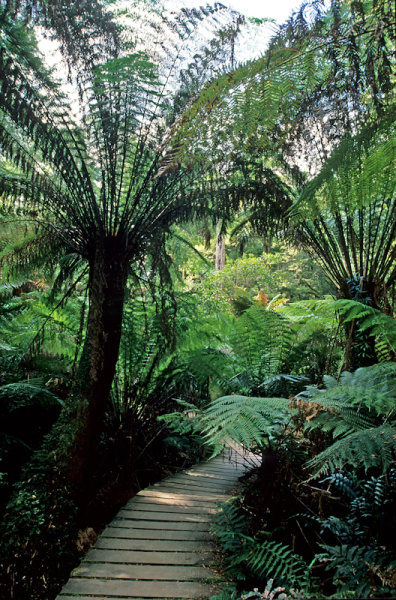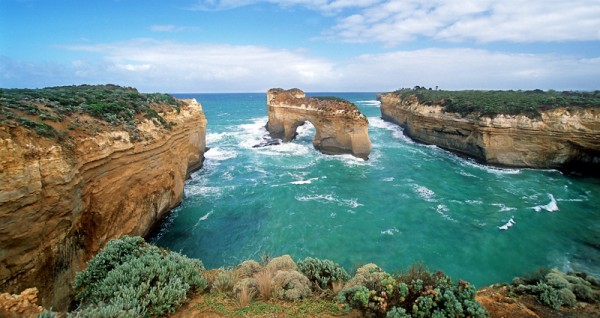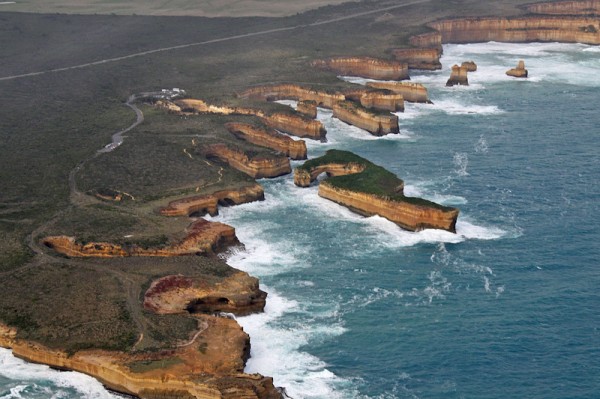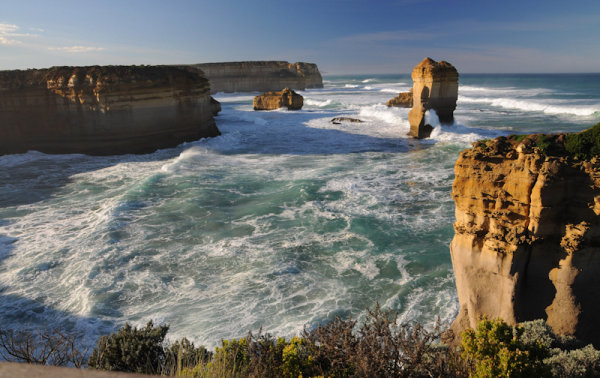A Guest Post by Cliff Kolber – Photography by Cliff Kolber and Doris Kolber

Sunset at Twelve Apostles along the Great Ocean Road
Australia is an amazing country and continent. It has some of the most diverse and spectacular scenery in the world with the desolate outback, iconic red deserts, deep canyons, rugged coastlines, lush rainforests and the Great Barrier Reef.
Part of this astounding scenery is along the “The Great Ocean Road” located just south of Melbourne where the Southern Ocean constantly reshapes the landscape. Raging surf, ferocious seas and high winds have sculpted astounding rock cliffs and sandstone formations over millions of years. This area contains some of the most famous natural landmarks in the world and is an unending cornucopia of photography.
The Great Ocean Road can be driven in one day, but you really need to give it at least two, preferably three, to fully explore and appreciate the territory. The two lane highway hugs the coast for its entire length, 150 miles, between the towns of Torquay on the east and Warrnambool to the west. I’ve visited the area twice and on each occasion spent three days photographing the area. Anything less will cut your time short.

Along the Great Ocean Road in Otway National Park
On our most recent visit I carried my Nikon D300 and three Nikon zoom lenses: 12-24mm, 18-200mm and 80-400mm. Since the D300 has a 1.5x crop factor, these lenses covered the equivalent of 18mm-600mm at 35mm which was quite sufficient.
You’ll use all the lenses you’ve got on the variety of subjects from wide landscapes to macros, flowers, birds and wildlife. [If you’re familiar with HDR or have panoramic software you can have a field day along the Great Ocean Road utilizing these.]
The most famous landmarks along the Great Ocean Road are located in Port Campbell National Park and include the Twelve Apostles, Loch Ard Gorge, London Bridge, the Arch and the Grotto. Two gorgeous lighthouses, Split Rock and Cape Otway, were built along the coast to protect ships from those great formations. Although early morning and late afternoon produce the best light for photography, mid-day along the Great Ocean Road allows for less shadows interfering with your landscape shots of the formations.

Loch Ard Gorge 2002 – Shot before the Island Archway collapsed in 2009.
To capture the essence of the scenery and landmarks you should constantly ask yourself, “what is the subject?” and think about what attracted you to a particular scene. After shooting the wide landscapes simplify, zoom in, narrow the field of focus and zero in on what originally caught your attention. The point is that you can capture the essence of a huge scene more realistically by photographing just a small portion of that expansive view.
It is important to use a tripod along the Great Ocean Road. There are sturdy, compact tripods that are perfect for travel. Gitzo makes some that weigh under three pounds and fold to 20”. By adding a quality lightweight ballhead you have a setup that will keep your equipment solid in the constant breezes and will travel with you easily. I carry a Gitzo 1155T tripod (2 lbs) topped off with a Really Right Stuff BH-40 ballhead (1 lb). This is solid enough for zoom lenses up to 400mm f/5.6. The tripod supports over ten pounds of gear securely, fits into my carry-on luggage and passes through TSA security with no problem. With good tripod techniques you don’t need to lose any images to blur. The only issue is price – these tripods and ballheads are not cheap, but well worth the investment.
With strong winds along the Great Ocean Road you’ll be glad you brought a tripod. A sudden gust will send your unattended equipment to the ground in a flash. Unfortunately I know from personal experience. On my first visit I set up my tripod on a cliff along the coast when I turned around to get something out of my photo bag. A gust swooped in and blew the tripod over before I could reach around to grab it. I could only watch in horror as my tripod and camera, seemingly in slow-motion, headed for the ground. I grabbed the tripod as the camera hit the ground but it was too late. The lens hit first and cracked, but luckily the camera body was not damaged. It was not a good feeling. Fortunately I had two more lenses but it was a hard lesson — and a good reminder to never leave a tripod unattended, especially in a breeze.

Great Ocean Road and Shipwreck Coast from the air
Make time for a helicopter ride over the Shipwreck Coast. It is an incredible and amazing way to see the landmarks and rugged shore from a bird’s eye view. The vast ferocity of the sea becomes more apparent from the air. The heliport is next to the Twelve Apostles visitor center and advance reservations are highly recommended. Photography from a helicopter adds a dimension to your portfolio that is not appreciated until you do it. The view along the Great Ocean Road is jaw-dropping with miles of rocky, rugged shoreline, cliffs and ferocious seas stretching out in front of you.
When shooting from a helicopter, stay relaxed, breathe easy, remain aware of your metering and settings and most importantly, keep shooting. It is easy to become excited about the view and forget camera basics. Don’t let that happen. Choose your lens before boarding and use just that one. Bring just your camera and lens; leave the bag and other gear in the car. You don’t want to waste time changing lenses; the landscape moves quickly and you do not get a second chance for a shot. I generally use the 18-200mm zoom lens in helicopters because of its wide range of focal lengths. If the helicopter window is closed hold the camera against the pane and use your hand to minimize vibrations. Otherwise remember to cradle the camera securely in your hands. Whether you meter in manual or Aperture Priority mode try to choose your settings and metering ahead of time. You want to spend minimal time in the helicopter fidgeting with settings and metering. You’d rather have your flight time filled with easy breathing, image composition and shooting.

Loch Ard Gorge 2010
Forces of nature have changed the landscape over the past 25 years, with three major incidents as prime examples:
- London Bridge used to have two high arches, making the formation appear like the famous bridge. In 1990 the largest of the arches collapsed, leaving an island in the ocean, as seen in the image.
- The Twelve Apostles, the most famous landmark in the region, is now only eight Apostles. Four of the sea stacks have collapsed over the years.
- The centerpiece of Loch Ard Gorge, the “Island Archway” collapsed in July 2009. You can see the difference in the images shot in 2002, before the collapse, and in 2010.
The Great Ocean Road is an incredible experience. If you get the opportunity to visit I am
sure you will come home with some exceptional images.
Cliff Kolber is a nature and travel photographer and writer based in Miami, Florida. He and his wife Doris have created a spectacular portfolio of images and articles from around the world, specializing in the Florida Everglades, the American Southwest. Australia and Antarctica. Visit their website for world-wide photography, travels and newsletters.
Post from: Digital Photography School's Photography Tips. Check out our resources on Portrait Photography Tips, Travel Photography Tips and Understanding Digital Cameras.

Photographing The Great Ocean Road: Victoria, Australia
No comments:
Post a Comment